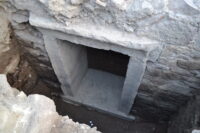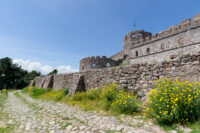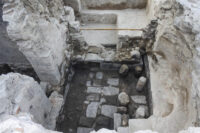 Archaeological surveys at the medieval castle of Mytilene on the island of Lesbos have discovered a massive Byzantine-era doorway. The doorway is 3.2 meters (10’6″) high, 2.05 meters (6’9″) wide and two meters (6’7″) deep. It was was made of nine slabs of locally sourced gray-white marble mortared together. There was a wooden door attached originally, although all that remains attesting to it are cavities in the lintel where it was hinged. There are some areas of decorative carving surviving — ribbons and a convex wave on the sides, a convex cornice across the top. Coins found date it to the 7th century A.D. making it the oldest
Archaeological surveys at the medieval castle of Mytilene on the island of Lesbos have discovered a massive Byzantine-era doorway. The doorway is 3.2 meters (10’6″) high, 2.05 meters (6’9″) wide and two meters (6’7″) deep. It was was made of nine slabs of locally sourced gray-white marble mortared together. There was a wooden door attached originally, although all that remains attesting to it are cavities in the lintel where it was hinged. There are some areas of decorative carving surviving — ribbons and a convex wave on the sides, a convex cornice across the top. Coins found date it to the 7th century A.D. making it the oldest
The urban settlement Mytilene dates back at least to the 7th century B.C. (Pseudo-Herodotus’ entirely unreliable Life of Homer places its founding way earlier, in the 11th century B.C.). In its long history it has been conquered by Persians, Romans, Byzantines, Genoese, Venetians and Ottomans before becoming part of modern Greece in 1923.
The earliest confirmed building phase of the castle took place in the 6th century in the reign of Justinian I (r. 527-565), but it may have been constructed on top of what was once the city’s acropolis incorporating elements of its ancient sanctuaries. Much of the medieval castle was built by Francesco I Gattilusio, a Genoese pirate who was given Lesbos by Byzantine Emperor John V in 1355 as a dowry when Gattilusio married the emperor’s sister Maria Palaiologina. The fortress fell to Ottoman forces under Mehmed the Conqueror in 1462 and it took heavy damage from Ottoman bombardment. Sultan Bayezid II repaired and expanded the castle in the early 16th century. Lesbos remained an Ottoman territory until late 1912 when it was taken by Greek naval operations in the First Balkan War.
 Today the castle complex is one of the largest in the Mediterranean covering 60 acres. The complex is divided into three parts: the Upper Castle is at the top of the hill where the ancient acropolis stood; the Middle Castle mostly dates to the Gattilusio expansion; the Lower Castle was believed to be an Ottoman addition, built in 1644 by Sultan Ibrahim to strengthen the fortifications of the northern port as he embarked on what would become a 24-year-long war in the Aegean against the Republic of Venice.
Today the castle complex is one of the largest in the Mediterranean covering 60 acres. The complex is divided into three parts: the Upper Castle is at the top of the hill where the ancient acropolis stood; the Middle Castle mostly dates to the Gattilusio expansion; the Lower Castle was believed to be an Ottoman addition, built in 1644 by Sultan Ibrahim to strengthen the fortifications of the northern port as he embarked on what would become a 24-year-long war in the Aegean against the Republic of Venice.
Very few remains from the early Byzantine period are extant. They include a small gate on the northeastern wall, the eastern wall of the Upper Castle and the cistern in the Middle Castle. The discovery of the doorway, therefore, sheds new light on the architecture of the castle in its first phase. Archaeologists also believe it may be connected to the Byzantine settlement of Melanoudi, a residential settlement within the castle’s defensive walls whose location was previously unknown.
 The doorway had been buried for centuries under layers of ash generated by another discovery made at the site: a 16th century bathhouse built by another pirate, Ottoman admiral and Lesbos native Hayreddin Barbarossa whose father had fought with Mehmed the Conqueror and settled on the island after the conquest. The remains of vaulted hot, warm and cold rooms of the bath complex were found, as well as the remains of the fire pits beneath. It is the oldest bath found on Lesbos, which has quite a few thanks to its centuries under Ottoman rule.
The doorway had been buried for centuries under layers of ash generated by another discovery made at the site: a 16th century bathhouse built by another pirate, Ottoman admiral and Lesbos native Hayreddin Barbarossa whose father had fought with Mehmed the Conqueror and settled on the island after the conquest. The remains of vaulted hot, warm and cold rooms of the bath complex were found, as well as the remains of the fire pits beneath. It is the oldest bath found on Lesbos, which has quite a few thanks to its centuries under Ottoman rule.